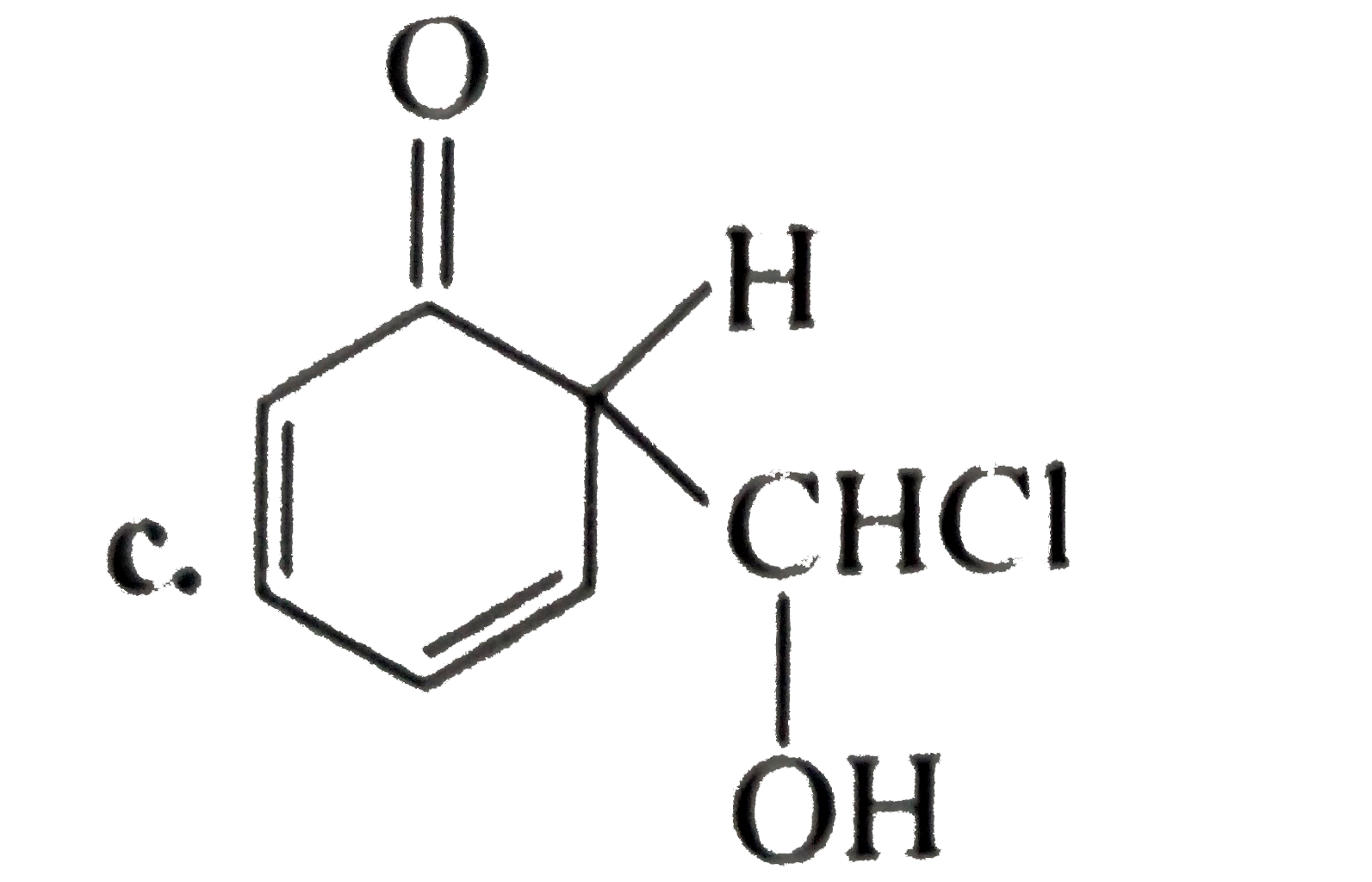When phenol is reactes with CHCI3 and NaOH followed by acidification, salicyladehyde is obtained. Which of the following species are involed in the above-mentioned reaction as intermediates ?




The correct Answer is:A, D
To solve the question regarding the reaction of phenol with chloroform (CHCl₃) and sodium hydroxide (NaOH) to form salicylaldehyde, we will analyze the reaction step-by-step and identify the intermediates involved.
1. Identify the Reactants:
- The reactants in this reaction are phenol (C₆H₅OH), chloroform (CHCl₃), and sodium hydroxide (NaOH).
2. Formation of Dichlorocarbene:
- When chloroform reacts with sodium hydroxide, a base, it undergoes deprotonation. The hydroxide ion (OH⁻) from NaOH removes a hydrogen atom from chloroform, leading to the formation of an intermediate called dichlorocarbene (CCl₂).
- Reaction:
CHCl₃+OH⁻→CCl₂+H₂O+Cl⁻
3. Electrophilic Attack on Phenol:
- The dichlorocarbene (CCl₂) acts as an electrophile and attacks the phenoxide ion (the deprotonated form of phenol). The phenoxide ion is formed when phenol loses a hydrogen ion (H⁺).
- The attack occurs at the ortho position of the phenoxide ion, leading to the formation of an intermediate compound.
4. Formation of Intermediate:
- The intermediate formed after the attack of dichlorocarbene on the phenoxide ion can be represented as:
C6H4(OH)(CCl2)
- This intermediate contains both the hydroxyl group (OH) and the dichlorocarbene moiety.
5. Rearrangement and Hydrolysis:
- The intermediate undergoes rearrangement where one of the chlorine atoms is replaced by a hydroxyl group (OH) through hydrolysis, facilitated by the presence of water or hydroxide ions.
- This leads to the formation of salicylaldehyde (ortho-hydroxybenzaldehyde).
- Reaction:
C6H4(OH)(CCl2)→C6H4(OH)(CHO)+HCl+H2O
6. Final Product:
- The final product obtained is salicylaldehyde (C₇H₆O₂), which is ortho-hydroxybenzaldehyde.
Conclusion:
The intermediates involved in the reaction are:
- Dichlorocarbene (CCl₂)
- Intermediate compound formed after the electrophilic attack
- The reactants in this reaction are phenol (C₆H₅OH), chloroform (CHCl₃), and sodium hydroxide (NaOH).
- When chloroform reacts with sodium hydroxide, a base, it undergoes deprotonation. The hydroxide ion (OH⁻) from NaOH removes a hydrogen atom from chloroform, leading to the formation of an intermediate called dichlorocarbene (CCl₂).
- Reaction:
CHCl₃+OH⁻→CCl₂+H₂O+Cl⁻
- The dichlorocarbene (CCl₂) acts as an electrophile and attacks the phenoxide ion (the deprotonated form of phenol). The phenoxide ion is formed when phenol loses a hydrogen ion (H⁺).
- The attack occurs at the ortho position of the phenoxide ion, leading to the formation of an intermediate compound.
- The intermediate formed after the attack of dichlorocarbene on the phenoxide ion can be represented as:
C6H4(OH)(CCl2)
- This intermediate contains both the hydroxyl group (OH) and the dichlorocarbene moiety.
- The intermediate undergoes rearrangement where one of the chlorine atoms is replaced by a hydroxyl group (OH) through hydrolysis, facilitated by the presence of water or hydroxide ions.
- This leads to the formation of salicylaldehyde (ortho-hydroxybenzaldehyde).
- Reaction:
C6H4(OH)(CCl2)→C6H4(OH)(CHO)+HCl+H2O
- The final product obtained is salicylaldehyde (C₇H₆O₂), which is ortho-hydroxybenzaldehyde.
The intermediates involved in the reaction are:
- Dichlorocarbene (CCl₂)
- Intermediate compound formed after the electrophilic attack
Topper's Solved these Questions
- BOOK - CENGAGE CHEMISTRY ENGLISHCHAPTER - ALCOHOL,PHENOL AND ETHERSEXERCISE - Archives Fill In The Blanks6videos
ALCOHOL,PHENOL AND ETHERS
- BOOK - CENGAGE CHEMISTRY ENGLISHCHAPTER - ALCOHOL,PHENOL AND ETHERSEXERCISE - Archives True/False1videos
ALCOHOL,PHENOL AND ETHERS
- BOOK - CENGAGE CHEMISTRY ENGLISHCHAPTER - ALCOHOL,PHENOL AND ETHERSEXERCISE - Archives Linked Comprehension2videos
ALCOHOL,PHENOL AND ETHERS
- BOOK - CENGAGE CHEMISTRY ENGLISHCHAPTER - ALIPHATIC AND AROMATIC ALDEHYDES AND KETONESEXERCISE - Archives Subjective26videos
ALIPHATIC AND AROMATIC ALDEHYDES AND KETONES
Similar Questions
Knowledge Check
- Question 1 - Select One or More
Which of the following are possible intermediate in the following reaction?
 A
A B
B C
C D
D
- Question 2 - Select One

Which of the following products can be obtained from above reaction ?A B
B C
C DAll of these
DAll of these - Question 3 - Select One

Which of the following reagents will not react with above compound ?ANa metalBAgNO3+NH4OHCCu2Cl2+NH4OHDNaHCO3
Which of the following reactions will yield phenol ?
View SolutionWhich of the following reaction mechanism doe not involves carbocation as an intermediate ?
View SolutionPhosphine is not obtained by which of the following reaction?
View SolutionIn which of the following reactions phenol is not obtained:
View SolutionWhich of the following reactions will not yield phenol ?
View Solution

